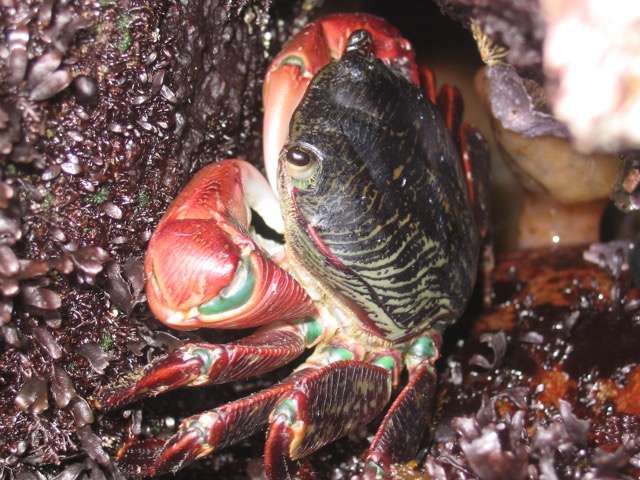Climate change could cause cold-blooded animals' thermal tolerance to shrink

Cold-blooded animals can tolerate body temperatures only a few degrees above their normal high temperatures before they overheat, which could be a problem as the planet itself warms, according to San Francisco State University researchers.
Ectotherms such as fish, reptiles and insects can stretch their body's tolerance of high and low temperatures a little bit at each extreme, but that stretch, or plasticity, is relatively small, the scientists found. As a result, the animals will see their "thermal safety margins" shrink as global temperatures rise, said postdoctoral researcher Alex Gunderson and Professor of Biology Jonathon Stillman, of SF State's Romberg Tiburon Center for Environmental Studies.
A land-dwelling ectotherm such as a lizard could increase its thermal tolerance by about one degree only after experiencing an increase in environmental temperatures of 10 degrees, making it difficult to keep pace with rising temperatures, Gunderson noted. As a result, shifts in behavior or evolutionary changes "might be their best hope if they reach a point where they're being really challenged by climate change," he added.
However, animals that live in water might not have as many options as land animals for changing their behavior, the researchers note, and it's unclear how long it might take most ectotherms to evolve tolerances to higher temperatures.
The study, published today in the Proceedings of the Royal Society B, examined thermal plasticity in 232 species of insects, crustaceans, fish, amphibians and reptiles. Thermal plasticity is a measure of the "wiggle room" that an animal has at extreme temperatures, where it can maintain its normal functions even as outside temperatures rise or fall above the animal's optimal body temperature.
Researchers have assumed that this plasticity follows certain patterns among ectotherms. For instance, daily and seasonal temperatures vary more widely at higher latitudes, so it might make sense for higher-latitude ectotherms to have higher plasticity to track those variations. At the same time, animals living at lower latitudes might be expected to have less plasticity, since they would experience fewer temperature fluctuations in the tropics.
Scientists, including Stillman, have also proposed that ectotherms that can thrive in the hottest temperatures would have the least amount of plasticity, since they might be at the limits of thermal tolerance already.
"Our data set is really the first one to compile a comprehensive analysis across ectotherms generally, to see whether these patterns hold up," Gunderson explained. He and Stillman were surprised to find that they did not. For instance, the researchers found no strong link between latitude and thermal plasticity when it comes to high temperatures.
Gunderson said animals living at higher latitudes might not have as much built-in ability to stretch their heat tolerances because they can instead change their habits to cope with extreme temperatures by doing such things as taking shelter in shade during the hottest part of the day.
"What we propose is that the ability of animals to mediate their thermal environment through their behavior is buffering them" against temperature variations, Gunderson noted.
"This research represents a great scientific process of testing hypotheses with larger and more comprehensive data sets," Stillman added. "What we know to be true about diversity and adaptation of thermal tolerances when looking at specific groups of animals is not necessarily true when expanded across all animals."
The researchers did see more thermal plasticity associated with changes in latitude at the coldest end of the temperature range, perhaps because there aren't as many ways for animals to "behaviorally buffer themselves against cold temperatures," Gunderson said. Ectotherms typically experience lowest temperatures at night, when there is less overall temperature variation and the animals can't do things like vary the amount of sun they soak up.
Gunderson and Stillman also found that aquatic animals have higher levels of thermal plasticity than terrestrial animals. This may be because they live in an environment with less temperature variation and fewer options for protecting themselves through behavioral changes, such as using trees for shade.
Gunderson said he and Stillman would like to pair their study's plasticity data with a map of daily and seasonal fluctuations in temperature at several locations around the globe. That data, along with predictions of how temperatures might change in those areas as the planet warms, could tell the scientists more about what temperatures an ectotherm species could tolerate in the future.
In order to make the most "generalizable results useful for accurate understanding of species responses to climate change," says Stillman "broad studies like this one are really important."
More information: "Plasticity in thermal tolerance has limited potential to buffer ectotherms from global warming" by Gunderson and Stillman was published in Proceedings of the Royal Society B on May 19. rspb.royalsocietypublishing.or … .1098/rspb.2015.0401
Journal information: Proceedings of the Royal Society B
Provided by San Francisco State University




















